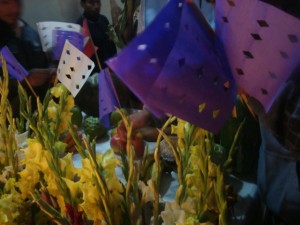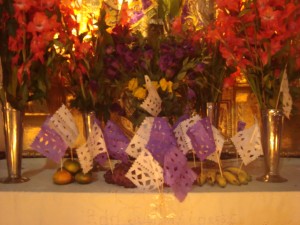Corn, Squash, and Potatoes for the Saints on Holy Thursday

Ears of corn and freshly harvested potatoes were placed yesterday midday in the Temple of San Sebastian, a suburban and ancient city of Cuzco. Offerings of food to holy figures are not uncommon in Cuzco, following a very old tradition with pre-Colombian roots. But this important one is largely off the radar of the official promoters of tourism which focus mostly on the formal events defined as important by the diocese.
Although Holy Week may focus liturgically on the passion of Christ, it also is a harvest festival in Cuzco. The death of Christ fits into the agricultural society of Cuzco and nearby areas as fitting the birth and death, the planting and harvest, of food crops. It becomes part of ideas and practices about how people get food.
M. Percy Paz Flores, an anthropologist who graduated from Cuzco’s local university, the San Antonio Abad National University, published an article detailing the customs in San Sebastian for Holy Week.
According to Paz, Thursday between noon and six pm, while most Cusqueños are preparing the meal they will share with their families on Good Friday — the twelve dishes representing the twelve apostles, in which religion is made food and eaten by the faithful — those couples who agreed to carry out the burden of feast sponsorship for one of the holy images during the year carry bundles of freshly harvested food and arrange it on the altars of the various holy figures.
Paz connects this custom with the Inca harvest rituals that took place at a similar time. But, instead of drawing his comparison with the rituals of the imperial court and its fastuosity, Paz relates it to the local and family customs at harvest time. To this end he quotes the Jesuit chronicler Joseph de Acosta.

In this moon and month, that is when the corn of the time is brought home, they did the feast which today is very strong among the Indians and is called Aymoray. They make the feast from their fields, or inheritance, to their houses, singing certain songs in which they pray the corn will last a long time. They call the corn Mamacora [lady corn.] They take from the field a certain amount of special corn and place it in a small bin which they call pirua with certain ceremonies. They sit with it for three nights. They put this corn in the best cloth they have and, after it is covered and dressed, they adorn the pirua and have a great veneration for it. They say it is the mother of the corn from their fields and with that given the corn is preserved. During this month they make a special sacrifice and the sorcerers ask the pirua if it has enough strength to last the year. If it answers “no”, they take it out to the field to burn it with as much solemnity as each person can. Then they make another pirua with the same ceremonies. They say they renew it so that the corn seed will not perish. If it responds that it has the strength to last more, they leave it for another year. This impertinence lasts until today. It is very common among the Indians to make the piruas and the feast of Aymoray.
Paz claims these traditions became part of Christian devotion during the colonial period. “The first and best fruits were destined to the deities,” he writes citing colonial commentators.
In current times, the couple who is carrying the burden for the community and the saint will take food to the altars of the saints on Good Thursday. Preferably the products should be from the couple’s own fields and the product of their own work, although today, when so many people live full time in the city and no longer cultivate fields, they can buy them in the markets.
But the food items should be distinctive and of good quality, as befits a sacrificial offering. They must stand out from the bulk of similar products. These may include ears and stalks of corn–the ears large with perfect rows of well formed kernels untouched by insects or birds, potatoes–they should be large with few eyes and preferably sweet of two kinds, wayro and qonpis, of the hundreds grown in Cuzco, carrots also large and well formed of good color and undamaged, cabbage that is large and well formed with no damage, squash that is large and shiny.
The carguyuqkuna, as the burden bearers are called, also give fruits from other areas of Peru that are bought in the market, so long as they are of outstanding quality.

Besides agricultural products people offer “empanadas de semana santa,” special pastries that are made for the season in local bakeries. In addition they offer pan chuta, bread from the town of Oropesa. This bread is considered to have “great religious value” (p 168.)
People say the best products are those harvested that morning when the first rays of sun come to burn off the dew. The sun heats them and makes them sweet, the people believe.
Between lunch and dusk the products are taken to the Church and carefully placed on and around the altars. First people pray and ask permission to make the offering, following an Andean ritual tradition with Inca roots. Then the products are placed on the altar, on a new cloth covered in plastic to protect it, in pairs, since the couple is a key idea in local culture. Afterwards flowers are added to the offering and spirals of colorful paper complete the offering. Then candles in pairs are lit to the saint.

Corn and potatoes, the sacred dual foods that make life around Cuzco possible and that figure in many, many dishes, along with the rest of the offerings pass the night in the temple as well as the following day. In the evening of Good Friday they are collected and removed, having met their purpose on this most significant day of the Christian calendar when the Lord lies in a tomb, just as the son sleeps every night. That night or the next day, Saturday of Glory, the food is shared with family, friends, and the needy, following the important Andean norm of sharing food and the holy.
Thus is food, raw and uncooked — although already the recipient of human work and the energy of the sun — tied to the Christian calendar and cosmology as Cuzco moves into a new period when the land rests and the great celebrations of winter take place.
Reference:
M. Percy Paz Flores, “Ofrendas de Jueves Santo, Templo de San Sebastián — Cuzco” in Jorge A. Flores Ochoa, ed. Celebrando la Fe: Fiesta y Devoción en el Cuzco (Cuzco, UNSAAC-CBC, 2009) pp. 159-178.




